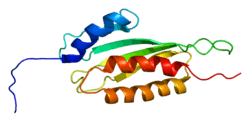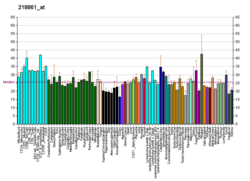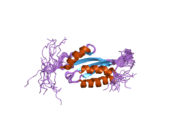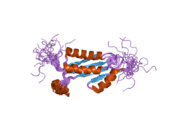RNF25
E3 ubiquitin-protein ligase RNF25 is an enzyme that in humans is encoded by the RNF25 gene.[5][6]
Function
The protein encoded by this gene contains a RING finger motif. The mouse counterpart of this protein has been shown to interact with Rela, the p65 subunit of NF-kappaB (NFKB), and modulate NFKB-mediated transcription activity. The mouse protein also binds ubiquitin-conjugating enzymes (E2s) and is a substrate for E2-dependent ubiquitination.[6]
Interactions
RNF25 has been shown to interact with RELA.[5]
References
Further reading
- Rual JF, Venkatesan K, Hao T, Hirozane-Kishikawa T, Dricot A, Li N, Berriz GF, Gibbons FD, Dreze M, Ayivi-Guedehoussou N, Klitgord N, Simon C, Boxem M, Milstein S, Rosenberg J, Goldberg DS, Zhang LV, Wong SL, Franklin G, Li S, Albala JS, Lim J, Fraughton C, Llamosas E, Cevik S, Bex C, Lamesch P, Sikorski RS, Vandenhaute J, Zoghbi HY, Smolyar A, Bosak S, Sequerra R, Doucette-Stamm L, Cusick ME, Hill DE, Roth FP, Vidal M (2005). "Towards a proteome-scale map of the human protein-protein interaction network". Nature. 437 (7062): 1173–8. PMID 16189514. doi:10.1038/nature04209.
- Lorick KL, Jensen JP, Fang S, Ong AM, Hatakeyama S, Weissman AM (1999). "RING fingers mediate ubiquitin-conjugating enzyme (E2)-dependent ubiquitination". Proc. Natl. Acad. Sci. U.S.A. 96 (20): 11364–9. PMC 18039
 . PMID 10500182. doi:10.1073/pnas.96.20.11364.
. PMID 10500182. doi:10.1073/pnas.96.20.11364.
- Suzuki Y, Yoshitomo-Nakagawa K, Maruyama K, Suyama A, Sugano S (1997). "Construction and characterization of a full length-enriched and a 5'-end-enriched cDNA library". Gene. 200 (1-2): 149–56. PMID 9373149. doi:10.1016/S0378-1119(97)00411-3.
- Maruyama K, Sugano S (1994). "Oligo-capping: a simple method to replace the cap structure of eukaryotic mRNAs with oligoribonucleotides". Gene. 138 (1-2): 171–4. PMID 8125298. doi:10.1016/0378-1119(94)90802-8.
PDB gallery |
|---|
| 2day: Solution structure of the RWD domain of human ring finger protein 25 |
| 2dmf: An extended conformation of the RWD domain of human Ring finger protein 25 |
|
|

 . PMID 10500182. doi:10.1073/pnas.96.20.11364.
. PMID 10500182. doi:10.1073/pnas.96.20.11364.





